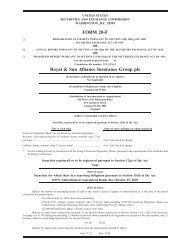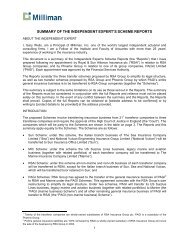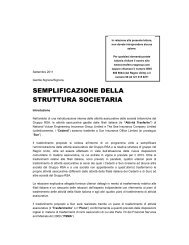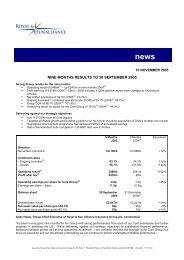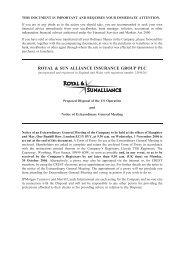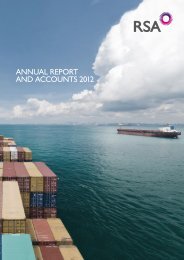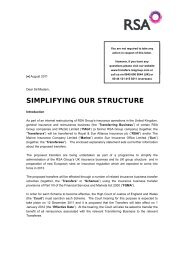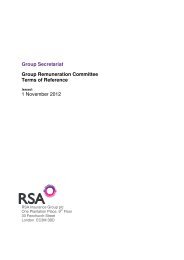RSA RETAIL RESEARCH PAPER2 WEB HR.pdf
RSA RETAIL RESEARCH PAPER2 WEB HR.pdf
RSA RETAIL RESEARCH PAPER2 WEB HR.pdf
Create successful ePaper yourself
Turn your PDF publications into a flip-book with our unique Google optimized e-Paper software.
PAPER 2:<br />
THE POWER OF<br />
THE CONSUMER
<strong>RSA</strong>: THE <strong>RETAIL</strong> SERIES –<br />
THE POWER OF THE CONSUMER<br />
We have spent time over the last 18 months developing our<br />
understanding of what Retailers want and the issues they face. We<br />
know the Retail market is forever changing and we are committed<br />
to working with our Retail customers and brokers to continuously<br />
understand their changing needs.<br />
This paper is the second in a series of short papers dedicated to<br />
what we believe are some of the most important challenges and<br />
opportunities facing Retailers.<br />
We hope that you will fi nd it useful and that it will provoke ideas<br />
for your business.<br />
This paper focuses on the Power of the Consumer and has<br />
been produced by <strong>RSA</strong> Global Europe in conjunction with Retail<br />
customers, brokers, experts and researchers in the fi elds covered.<br />
Look out for the next Retail Research Papers on:<br />
• Sustainability Challenges for Retailers<br />
• The Future of Retailing<br />
• <strong>RSA</strong> and Retail Insurance<br />
We hope you will fi nd this series of papers interesting and, as ever,<br />
we would welcome any feedback you have or suggestions for<br />
topics you would like covered in the future.<br />
If you would like to contact us about these Retail Research<br />
papers then please email: smc.europe@uk.rsagroup.com.<br />
C<strong>HR</strong>IS SMITH<br />
Written with the support of Liz Machtynger of Customer Essential.
THE POWER<br />
OF THE CONSUMER<br />
UNDERSTANDING THE CONSUMER IS AN<br />
ONGOING JOURNEY FOR US ALL.<br />
Many external factors lead to changes in consumer behaviour,<br />
meaning research papers and journals from a year ago rarely<br />
scratch the surface of the Retailing challenges of today. This paper<br />
is drawn from a number of recent sources and papers particularly<br />
focused on the European marketplace.<br />
The paper is split into the following fi ve themes:<br />
1. The world is getting smaller<br />
2. The changing face of our consumer population<br />
3. Economic challenges and the impact on consumers<br />
4. Do consumers really care where they buy?<br />
5. Which Retailers are consumers voting for?<br />
A SNAPSHOT OF THE CHANGING CONSUMER<br />
There have been some major changes over the past fi ve years that<br />
have led to a different set of consuming habits worldwide:<br />
• The population has seen a shift in the shape of family units<br />
and a move to more urban living.<br />
• People are living much longer than before, in particular<br />
in Europe.<br />
• Females are playing a much more important role and have<br />
more fi nancial control than ever before.<br />
• The fi nancial situation is volatile worldwide and across Europe.<br />
These pressures are having a direct impact on the way that<br />
consumers are spending on basic necessities and is reducing any<br />
discretionary spend they may have.<br />
• Consumers choose to buy from Retailers based upon their own<br />
priorities. Their priorities are more strongly focused than ever<br />
before on ‘value for money’ and ‘quality’ of their purchases.<br />
• Retailers wishing to hold on to their consumer base need to<br />
work hard to build trust and deliver consistently across the<br />
channels they operate in.<br />
• Consumers are more demanding in both product selection and<br />
service delivery. It is of paramount importance, therefore, that<br />
Retailers stay connected with their consumers to keep on top<br />
of their priorities.<br />
The power of the consumer to change the way they spend and<br />
the way they communicate with others about their purchases has<br />
never been clearer.<br />
“Today the consumer has power like never before. Facilitated<br />
by technology, the humble shopper can reach an audience of<br />
thousands – or even millions – to praise, complain or merely<br />
muse about the service or products they get from Retailers.<br />
For the Retailer this makes brand reputation a challenge.<br />
Indeed, such is the power of consumers that a Retail brand<br />
is no longer what a Retailer says it is, it’s defi ned by what<br />
consumers feel and say about it. Naturally, all of this means<br />
speed of response, appropriateness of response and visibility<br />
of response are now critical.<br />
Across most of the Western world Retail is a mature business,<br />
and like most mature businesses that means it is competitive.<br />
This ultimately gives the consumer choice. In recent years,<br />
thanks to the Internet, this choice has been expanded beyond<br />
national boundaries and shoppers can use Retailers from<br />
around the world. With choice comes power. It is easier than<br />
ever to punish Retailers that get it wrong by simply taking<br />
custom elsewhere. The result is that all have had to up their<br />
game, become more nimble and reinvent their organisations<br />
to be truly customer centric.”<br />
Neil Saunders<br />
Managing Director of Conlumino Retail experts
THE WORLD IS GETTING SMALLER –<br />
WHO IS OUR CONSUMER?<br />
AN INTERESTING QUESTION...<br />
The world’s population has reached more than 7 billion, meaning<br />
we are increasingly getting closer in distance, and as consumers,<br />
technology and travel are making change move even faster.<br />
Ref. Google – World Population<br />
The number of households is growing, in some countries more<br />
rapidly than others, mainly due to emigration and changes in the<br />
typical size of family units (outlined later).<br />
NUMBER OF HOUSEHOLDS IN WESTERN EUROPE IN 000S.<br />
UK<br />
Turkey<br />
Switzerland<br />
Sweden<br />
Spain<br />
Portugal<br />
Norway<br />
Netherlands<br />
Italy<br />
Ireland<br />
Greece<br />
Germany<br />
France<br />
Finland<br />
Denmark<br />
Belgium<br />
Austria<br />
0 10000 20000 30000 40000 50000 60000 70000<br />
1990<br />
2010<br />
Ref. European marketing statistics Euromonitor.<br />
Typical habits and consuming trends are becoming more global<br />
as we see Retailers growing their presence in multiple countries<br />
and the media opens up the world to sharing. We know, however<br />
that there are still some substantial differences in the way that<br />
consumers behave between continents and countries, and even<br />
regions within countries. History and culture play a role in driving<br />
some of these differences through religion, beliefs and language.<br />
For the consumer, a trip to another country usually still offers<br />
a different experience or set of products, even though the<br />
differences are much less pronounced than they were 10 years ago<br />
or more.<br />
Local stores have maintained more of this difference than those in<br />
the high streets or main streets across Europe, where international<br />
brands have become the norm.<br />
Consumers across Europe often buy online, particularly in the UK,<br />
Germany and France in Western Europe, and growing in Eastern<br />
Europe, specifi cally Russia, Poland and the Czech Republic. These<br />
purchases are often from international Retailers.<br />
2010 INTERNET SALES $US BILLION<br />
UK<br />
Turkey<br />
Switzerland<br />
Sweden<br />
Spain<br />
Portugal<br />
Norway<br />
Netherlands<br />
Luxembourg<br />
Italy<br />
Ireland<br />
Greece<br />
Germany<br />
France<br />
Finland<br />
Denmark<br />
Belgium<br />
Austria<br />
TO SUMMARISE…<br />
0 10 20 30 40<br />
$US BILLION<br />
Ref. European marketing statistics Euromonitor.<br />
• Global consumers are becoming more alike with a big increase<br />
in buying via the Internet.<br />
• Niche and local businesses are retaining some cultural and<br />
personalised strengths that consumers welcome.
THE CHANGING FACE<br />
OF OUR POPULATION<br />
There have been some signifi cant changes in our world population<br />
over the past 5 – 10 years – too many to talk about in detail. There<br />
are some highlights that have already had a real affect on the<br />
consumer and the way in which Retail operates today.<br />
A ‘FAMILY’ IS NOT WHAT IT USED TO BE<br />
• On average approx. 30% or more of households in Europe have<br />
only one person living in them.<br />
• Almost 8% of households in the UK and France, 5% in Germany<br />
are single parent.<br />
• 41% of households in the UK have a female head.<br />
• 43% of households are headed by someone who is 60 years of<br />
age or more.<br />
• In Turkey 20% of heads of household are less than 29 years<br />
of age.<br />
Ref. Euromonitor 2012<br />
WE ARE LIVING IN CITIES MORE<br />
There are clear differences across Europe in the balance between<br />
city and rural dwellings, but the trends are moving towards<br />
urban living.<br />
URBAN RURAL SPLIT EXAMPLES:<br />
UK:<br />
90.1%<br />
9.9%<br />
URBAN<br />
RURAL<br />
FRANCE:<br />
79.3%<br />
URBAN<br />
20.7%<br />
RURAL<br />
Ref. Euromonitor 2012<br />
This shift is making the urban Retail arena more interesting, and<br />
Retailers are investing in stores in the more urban locations. Retail<br />
real estate in prime locations is in demand.
CULTURES ARE MIXED UP<br />
There has been a surge in migration activity in the past 10 years,<br />
with the ability to travel and work across the EU. This has meant<br />
that many countries have changed in cultural mix. This has brought<br />
many opportunities and challenges for countries across Europe.<br />
CITIES WITH 100,000 OR MORE FOREIGN-BORN RESIDENTS<br />
Ref. MPI
‘LIFELONG’ IS FOR LONGER<br />
Improvements in healthcare mean that people are living longer,<br />
which also means that they are consuming for longer. People are<br />
also more dependent on their pensions and public sector support<br />
later in life.<br />
There is a marked age difference with some other parts of<br />
the world:<br />
The median age in Europe is 40+<br />
The median age in Africa is 20+<br />
EUROPE IS MORE FEMALE<br />
Most countries in Europe have more women than men by one<br />
or two percentage points. Turkey, Cyprus, Iceland, Albania, and<br />
Macedonia have a slightly higher percentage of males.<br />
And women have a higher life expectancy than men overall.<br />
TO SUMMARISE…<br />
• Families are now all different shapes and sizes with the<br />
extended family unit often broken up.<br />
• People are living more in urban environments and moving<br />
across country borders.<br />
• People are living longer across Europe, much longer than Africa<br />
or South America.<br />
• Europe is more female.<br />
Ref. Google
ECONOMIC CHALLENGES AND<br />
CONSUMER CONFIDENCE<br />
CONSUMERS HAVE HAD TO RETHINK THEIR FINANCES<br />
The economic stresses of this century, so far, have changed the<br />
world forever and have had a massive impact on consuming<br />
habits. Consumers have experienced a credit crunch, recession<br />
and practical collapse of the fi nancial system. The Euro has come<br />
under great pressure as a result and there may still be more<br />
economic turmoil across Europe. Some countries such as Greece<br />
and Spain are struggling to turnaround major defi cits. This has had<br />
a major impact on the day to day lives of the inhabitants of those<br />
countries. Consumers have seen rising bills, rising taxation, rising<br />
unemployment and reductions in public services.<br />
For many of the countries across Europe, Retail prices have either<br />
been reducing or going up only steadily. In the UK and Germany,<br />
prices have begun to go up on core products.<br />
For Retailers across Europe, there have been visible changes to<br />
sales volumes with, on the whole, steady declines.<br />
<strong>RETAIL</strong> SALES 2009 – 2010<br />
% Growth PA<br />
10%<br />
5%<br />
0%<br />
-5%<br />
-10%<br />
-15%<br />
-20%<br />
Russia<br />
Luxembourg<br />
Poland<br />
Sweden<br />
Turkey<br />
Austria<br />
France<br />
UK<br />
Switzerland<br />
Norway<br />
Finland<br />
Belgium<br />
Italy<br />
Eurozone<br />
Germany<br />
Portugal<br />
Czech Republic<br />
Denmark<br />
Netherlands<br />
Hungary<br />
Ireland<br />
Spain<br />
Slovenia<br />
Slovakia<br />
Bulgaria<br />
Romania<br />
Greece<br />
Estonia<br />
Lithuania<br />
Latvia<br />
Ref. Cushman & Wakefi eld, Oxford Economics<br />
According to the statistics, previous recessions have seen food<br />
category sales least affected; this time round this category has also<br />
seen an impact, showing how tough things have been<br />
for consumers.<br />
Consumers once trusted fi nancial institutions almost above all<br />
others. This trust has vanished and there is widespread distrust of<br />
fi nancial institutions in general. There is also now less willingness<br />
or ability to invest for the future. There are major concerns as we<br />
write this for further recession and for further impacts of defi cit<br />
in the Euro.<br />
POVERTY IS A GROWING ISSUE WORLDWIDE<br />
Nearly half of the world (48%) lives in poverty.<br />
Poverty is pronounced deprivation in well-being, and comprises<br />
many dimensions. It includes low incomes and the inability to<br />
acquire the basic goods and services necessary for survival<br />
with dignity. Poverty also encompasses low levels of health and<br />
education, poor access to clean water and sanitation, inadequate<br />
physical security, lack of voice, and insuffi cient capacity and<br />
opportunity to better one’s life.<br />
World Bank[5]<br />
The poorest countries are growing at the quickest rate. This makes<br />
a large shift away from poverty very diffi cult.<br />
POPULATION CLOCK 2011<br />
World<br />
More Developed<br />
Countries<br />
Less Developed<br />
Countries<br />
Population 6,986,951,000 1,241,580,000 5,745,371,000<br />
Births per Year 139,558,000 14,070,000 125,488,000<br />
Day 382,351 38,548 343,803<br />
Minute 266 27 239<br />
Deaths per Year 56,611,000 12,201,000 44,410,000<br />
Day 155,099 33,427 121,671<br />
Minute 108 23 84<br />
Natural increase<br />
Natural increase<br />
Year 82,947,000 1,869,000 81,078,000<br />
(births-deaths)per Day 227,252 5,121 222,132<br />
Minute 158 4 154<br />
Infant deaths per Year 6,078,000 77,000 6,001,000<br />
Day 16,652 211 16,441<br />
Minute 12 0.1 11<br />
Ref. Population reference bureau<br />
Some areas within Europe are also poor and getting poorer as the<br />
economic situation worsens.<br />
SPENDING POWER HAS BECOME MORE FEMALE<br />
Spending power for females has increased, although in many cases<br />
there is still a difference in earnings with male counterparts.<br />
Some examples within Europe:<br />
• In Switzerland 61% of females are economically active vs<br />
74% of males.<br />
• In comparison, in Iraq only 14% of females are economically<br />
active vs 19% of males.
YOUNG PEOPLE ARE STRUGGLING TO GET<br />
ON THE LADDER<br />
Younger people are struggling to get their feet on the work ladder<br />
and this is having an impact on debt levels for this age group.<br />
COUNTRIES WITH THE YOUNGEST AND OLDEST<br />
POPULATIONS 2011<br />
YOUNGEST % AGES
DO CONSUMERS REALLY<br />
CARE WHERE THEY BUY?<br />
WE TALK ABOUT ‘THE CONSUMER’, HOWEVER,<br />
IT IS MUCH MORE COMPLEX THAN THAT.<br />
Consumers have varying needs and wants at different times and<br />
depending on how and why they are purchasing. However, there<br />
are some trends that can be clearly seen from various research<br />
papers and individual Retailer successes or failures. These are<br />
forming invaluable reference points for the development of the<br />
Retail proposition.<br />
WILL THEY DELIVER VALUE FOR MONEY?<br />
Consumers have always ranked value for their money pretty highly<br />
in research surveys for Retailers, now it is a clear winner for many.<br />
All indications are that consumers with disposable income are<br />
making much more serious decisions about where they spend<br />
it. ‘The basics’ are coming fi rst for product purchases, and many<br />
‘value’ brands are going from strength to strength as a result. Those<br />
endeavouring to show that they have ‘best prices’ or ‘best packages’<br />
or ‘added value’ are picking up more regular consumers.<br />
But it is not all about having the cheapest price.<br />
A survey of 2,210 UK consumers conducted by Retail Eyes has<br />
found that less than one in fi ve people (17 per cent) intend to<br />
make purchasing decisions based on the lowest possible price.<br />
Tim Ogle, CEO of Retail Eyes, says that rock bottom pricing is<br />
not necessarily the best way to attract, and retain, customers.<br />
“Our research has shown that 83% of shoppers are looking for<br />
added value for their money. Obviously with their margins being<br />
squeezed by rising costs, Retailers need to fi nd cost effective<br />
ways to add value – one of which is through exceptional<br />
customer service”.<br />
Ref. Retail Eyes Jan 2011<br />
Dealing and negotiating are absolutely on the agenda for the<br />
consumer today. With increasing price comparison possibilities<br />
through the use of the web, and encouragement from the media<br />
and social media, consumers are becoming more courageous. In<br />
some countries, consumers now see the face-to-face Retail store<br />
as a way of bringing out their bargaining power. Some Retail brands<br />
are encouraging this further with ‘money back guarantees’ where<br />
lower prices can be found.<br />
The categories customers are spending on are changing too,<br />
refl ecting the more diffi cult fi nancial situations that consumers fi nd<br />
themselves in. Consumers are spending much more on things they<br />
need rather than things they want.<br />
CAN I JUSTIFY THIS PURCHASE?<br />
For a number of years there has been growing spending on ‘luxury’<br />
items, or things that consumers want e.g. the new iPhone or iPad,<br />
the expensive car or the designer handbag.<br />
The implications of the fi nancial crisis and economic impacts have<br />
meant a change in these patterns. This has not stopped consumers<br />
buying luxury items, but it has, in many cases, resulted in a more<br />
serious and discerning consumer selecting carefully their purchases<br />
based on the perceived value and timeless nature of the item<br />
they buy.<br />
Consumers are thinking more carefully about their spending<br />
on different categories and where they would prioritise their<br />
own budgets.<br />
ALLOCATION OF MONTHLY BUDGET<br />
EXPAND<br />
(10% INCREASE IN BUDGET)<br />
Travel/Vacation 29%<br />
Savings/Investments 25%<br />
Recreation/Entertainment 20%<br />
Dining Out 15%<br />
Electronics & Appliances 14%<br />
Apparel 11%<br />
Medical 10%<br />
Education 9%<br />
Transportation 6%<br />
Communication Services 5%<br />
Food & Beverage 5%<br />
Housing 1%<br />
-2% Medical<br />
-3% Housing<br />
-6% Education<br />
-7% Transportation<br />
-8% Food & Beverage<br />
-10% Communication Services<br />
-10% Savings/Investments<br />
-12% Recreation/Entertainment<br />
-12% Travel/Vacation<br />
-14% Electronics & Appliances<br />
-18% Dining Out<br />
-21% Apparel<br />
CONTRACT<br />
(10% DECREASE IN BUDGET)<br />
Ref. Neilsen Global Online Consumer Confi dence Survey, Q3 2011<br />
This research by Neilsen shows where, if consumers had a<br />
contraction in their budget by 10% or an expansion of about 10%,<br />
they would spend or reduce their budget.
WILL THEY HAVE THE RIGHT PRODUCTS/PACKAGE FOR ME?<br />
The pressures of time and fi nances mean that the fundamental<br />
need to fi nd products quickly and get them delivered or picked up<br />
as soon as possible remain crucial to the success of a Retailer.<br />
The benchmarks set by some<br />
global Retailers such as Amazon<br />
(in product range and delivery)<br />
have set expectations for<br />
the consumer. There is no doubt that Retailers combining their<br />
understanding of their consumer with their mechandising and<br />
logistics and warehousing strategies are currently winning through.<br />
ARE THEY A <strong>RETAIL</strong>ER I CAN TRUST?<br />
Who consumers trust to deliver the right thing for the right price<br />
and in the right way is a major challenge. If we look at the research<br />
available on ‘trust’, Retailers have made some headway.<br />
Financial Services<br />
Banking<br />
Insurance<br />
Media<br />
Brewing & Spirits<br />
OTC pers Healthcare<br />
Consumer packaged goods<br />
Energy<br />
Pharmaceuticals<br />
Entertainment<br />
Retail<br />
Biotechnology<br />
Food and Beverage<br />
Telecommunications<br />
Automotive<br />
Technology<br />
50%<br />
51%<br />
52%<br />
54%<br />
57%<br />
57%<br />
59%<br />
62%<br />
63%<br />
63%<br />
65%<br />
65%<br />
66%<br />
68%<br />
69%<br />
81%<br />
0% 20% 40% 60% 80% 100%<br />
Ref. Edelman.com research 2011<br />
Major investments are being made by Retailers worldwide to build<br />
brand visibility and trust. Retailers are investing in putting their<br />
brands at the forefront of the consumer’s mind when they come<br />
to making their purchasing decision. The elements that build trust<br />
for a consumer are often, however, about getting the basics right:<br />
• Doing what you promise<br />
• Consistently<br />
• With no major errors<br />
• And a turnaround strategy if you do things wrong.<br />
Also, the removal of any major risks for the customer are also<br />
key tools in building trust with your brand in the consumers’ eyes,<br />
e.g. taking care of their data, dealing with payments securely etc.<br />
Managing PR and negative stories relating to the Retailer are of<br />
paramount importance in ensuring that trust is not eroded.<br />
The importance of trust is becoming ever more important for<br />
consumers where they are physically removed from the Retailer<br />
and buying from them on the web or through mobile. Will they<br />
buy from an E-Retailer they do not know fi rst time?<br />
The network of people and communities that consumers place<br />
their trust in are becoming more important in this context. Family<br />
or friends’ experience of previous purchases in the fi rst line, then<br />
communities they have joined and trust to provide guidance on<br />
specifi c purchase decisions. Social media and the Internet are<br />
making these communities broader (sometimes international) and<br />
more responsive than before.<br />
This research shows the level of trust that consumers stated they<br />
had with specifi c industries.<br />
This could be, in part, due to the higher profi le comparisons being<br />
made with other industries and the way that they have treated<br />
their markets and customers e.g. banks.
DOES THIS <strong>RETAIL</strong>ER SUPPORT SOMETHING<br />
I CARE ABOUT?<br />
It is becoming increasingly important to identify Retailers that<br />
stand out in a busy market environment. Some customers will<br />
differentiate and make their choices based on the Retailer’s ethics<br />
and approach to doing business.<br />
There are some key areas where consumers would like to feel<br />
that they too are contributing to the right cause in spending<br />
their money:<br />
IKEA Named as One of the ‘World’s<br />
Most Ethical Companies’ for Fourth<br />
Consecutive Year in 2010<br />
“IKEA’s promotion of a sound ethical environment shines within<br />
its industry and shows a clear understanding that operating<br />
under the highest standards for business behaviour goes beyond<br />
goodwill and ‘lip-service’ and is intimately linked to performance<br />
and profi tability,” said Alex Brigham, Executive Director of the<br />
Ethisphere Institute.<br />
Environmental Impact<br />
Sustainability and a ‘greener’ product set or way of working is an<br />
area we will cover in a later paper in this series. For consumers,<br />
it is almost the beginning of the journey. Many are keen to make<br />
a difference in this area, however, fewer are making purchasing<br />
decisions driven by this issue. There are some Retailers beginning<br />
to make green consumer choices easier for the consumer. Marks<br />
& Spencer is one European Retailer that has been working on<br />
its own sustainability agenda for the past 7 years and has been<br />
applauded by the consumer for driving sustainable market<br />
behaviours such as reducing plastic bags and cutting delivery miles.<br />
DO THEY OFFER A GOOD SHOPPING EXPERIENCE?<br />
There has been much written about the customer experience<br />
and the need for Retailers to produce an improved approach<br />
to ‘in-store experience’ in order to retain customers. Many<br />
consumers have switched their shopping habits to an online<br />
environment, and usually due to:<br />
• Convenience<br />
• Price<br />
• Choice (perceived in some cases)<br />
• Information<br />
• Increased confi dence in security<br />
The in-store experience can offer some amazing additional<br />
benefi ts, for example:<br />
“We’re doing this because it’s what you want us to do. It’s also the<br />
right thing to do. We’re calling it Plan A because we believe it’s now<br />
the only way to do business.<br />
There is no Plan B.”<br />
CORPORATE RESPONSIBILITY<br />
Retailers with ethical or charitable causes are also respected for<br />
their work with local communities and beyond. IKEA Sweden is<br />
one such Retailer, having received recognition as a high-ranking<br />
ethical company from Ethisphere a research based international<br />
think tank.<br />
• Engaging interaction – a consumer can touch/feel/try<br />
the product<br />
• Informative – a consumer can be guided to things you had<br />
not previously considered<br />
• Surprising – a consumer can be taken into an experience<br />
or trial situation<br />
• Human – they can interact with another person.<br />
Online, mobile and even in-store processes must form part of<br />
an overarching multi-channel strategy to ensure that all channels<br />
are coherent with the brand in question and that they provide a<br />
consistently high quality experience, allowing customers to easily<br />
purchase what they want, when they want and through whatever<br />
method they want.<br />
Ref. Webcredible report on retail customer experience, Nov 2011.<br />
www.webcredible.co.uk
WILL THEY OFFER ME A BENEFIT FOR BUYING<br />
THERE BEFORE?<br />
Some consumers will look for those Retailers where they will be<br />
offered a benefi t as a returning customer.<br />
Most Retailers offer programs to drive more retention and loyalty<br />
to their customer base e.g.:<br />
• Tesco’s loyalty card, a points-based system offering vouchers and<br />
rewards based on points collected through purchases in store<br />
and online.<br />
• Voucher systems offered to customers buying up to<br />
certain thresholds.<br />
• Body Shop sales events for customers, and reminder system.<br />
• Starbucks targeted location offers for customers holding a card.<br />
• The Sainsbury’s Nectar card – a loyalty points-based system<br />
shared by multiple companies including Retailers.<br />
There are also consumers who are loyal to a brand. They return to<br />
buy at the same Retailer on a regular basis because they see it as<br />
‘their supermarket’ or ‘their clothes brand’. For these consumers,<br />
the social media context has added an additional way to become<br />
connected to their Retailer of choice, as well as other consumers<br />
who feel the same way.<br />
“The number of customers in the DIY sector<br />
continues to grow despite the diffi cult economic<br />
conditions. However, the average shopping basket<br />
has decreased over the last couple of years with the exception of<br />
customers who own loyalty cards. Customers with a loyalty card<br />
can represent up to 50% of some of our branches’ turnover.”<br />
Elise Boudet, Insurance Manager – Adeo Services<br />
DO THEY HAVE THE LATEST OR NEW IDEAS?<br />
New ideas and products attract some consumers. They will look<br />
for Retailers consistently searching for and offering new items or<br />
services. They will search these Retailers out.<br />
Expert prediction.<br />
“The next few years will see consumers much more focused on<br />
value, in the home and out of it. After years of travelling all over the<br />
world, many consumers will retreat to enjoying themselves more<br />
at home and in their own country, helped by the Internet not<br />
just to obtain better value, but also to entertain themselves more<br />
cheaply – and their children will do the same, as the smartphoneaccessed<br />
Internet provides them with hours of endless fun and<br />
bans boredom, as well as providing the key to successful shopping<br />
for themselves and their parents, through mobile applications.<br />
Worries about the environment may have receded a little, though<br />
they will return, with the relentless rise in oil and raw material<br />
prices reminding consumers that the human race does have to<br />
worry about resources. Nonetheless, the outlook for Retailers may<br />
not be gloomy, as many consumers spend at home rather than<br />
going abroad”.<br />
Prof. Merlin Stone,<br />
Universities of Demontfort, Oxford Brookes and Portsmouth,<br />
Research Director The Customer Framework.<br />
TO SUMMARISE….<br />
• The consumer selects a Retailer based upon their<br />
own priorities.<br />
• Value for money and ensuring that the consumer feels they<br />
have made a correct decision are more important than<br />
ever before.<br />
• Finding the right product selection remains important for<br />
the consumer.<br />
• Retailers must consider the key ways to build trust with their<br />
consumer base through consistency of delivery in the key<br />
elements of their proposition.<br />
• The customer experience enables the Retailer to stand out<br />
for the customer, it is crucial to deliver it well across all channels.<br />
• Consumers are more aware of sustainability and community<br />
needs and are noticing the Retailers that are investing in<br />
these areas.
ENGAGING <strong>RETAIL</strong> BRANDS –<br />
VOTED BY CONSUMERS<br />
DOES ALL OF THIS MATTER?<br />
There is no clear measure of consumer feedback across all<br />
markets, although there are some messages in the research papers<br />
available showing that consumers are less happy with Retailers.<br />
The reasons for this could be many e.g. the fi nancial crisis making<br />
consumers more aware of pricing, the in-store experience not<br />
standing out in ways consumers would expect.<br />
Similarly we cannot rely on Retailers’ performance reports as<br />
an indicator of consumer preference, as there are so many<br />
diffi cult external factors that will have an impact on market share,<br />
profi tability etc.<br />
“ORC International, announced in January 2011, research fi ndings<br />
that showed that half of UK consumers are likely to encounter<br />
poor customer service in an average month. The worst culprit<br />
for poor service was the Retail sector, with 17% of respondents<br />
unimpressed with their experiences. Closely following were<br />
broadband suppliers and banks, with 16% and 15% respectively.”<br />
Ref. Prof Merlin Stone – The Death Of Customer Service In Retail<br />
TOP <strong>RETAIL</strong> BRANDS<br />
# Brand Brand Value<br />
$M<br />
Brand<br />
Contribution<br />
Brand<br />
Momentum<br />
Brand Value<br />
Change<br />
1 Walmart 39,421 2 8 -4%<br />
2 Amazon 27,459 4 9 29%<br />
3 Tesco 25,741 5 4 12%<br />
4 Carrefour 14,980 5 7 0%<br />
5 Target 12,148 4 7 -1%<br />
6 eBay 9,328 3 7 -28%<br />
7 Home Depot 8,971 2 3 -3%<br />
8 ALDI 8,747 1 6 1%<br />
9 Auchan 7,848 4 7 NA<br />
10 Lowe’s 7,008 2 5 10%<br />
11 Best Buy 5,807 3 8 18%<br />
12 IKEA 5,710 3 8 -15%<br />
13 Marks & Spencer 5,699 5 3 -5%<br />
14 Asda 4,922 3 7 -9%<br />
15 Kohl’s 4,371 4 5 12%<br />
16 Lidl 4,102 1 5 -1%<br />
17 Costco 3,875 1 4 -26%<br />
18 Sam’s Club 3,255 1 6 -7%<br />
19 Safeway 3,173 2 4 -8%<br />
20 Sainsbury’s 2,728 5 4 -4%<br />
Consumers will vote with their money. The fi nancial crisis has<br />
clearly impacted consumer spending with a slight increase or<br />
remaining the same across Europe. Those Retailers showing clearly<br />
improved fi nancial performance are ‘value’ brands and those having<br />
‘own brand’ goods such as Walmart, and some high-end luxury<br />
brands such as Mulberry Group.<br />
The brand ranking research database BrandZ, places Walmart,<br />
Carrefour, Aldi and Tesco in their top 20 brands globally.<br />
TO SUMMARISE...<br />
Ref. Millward Brown Optimer including data from BrandZ,<br />
Datamonitor and Bloomberg<br />
Understanding consumer preference and priorities and adapting<br />
to the pressures in the market at present are crucial for the<br />
survival of Retailers.<br />
Consumers are fi nancially pressured and voting for value. They<br />
are looking for ways that are meaningful to them to differentiate<br />
between Retailers, and moving seamlessly between channels<br />
to do so.<br />
Retailers are working with a rapidly changing set of consumers but<br />
must remember to keep their focus on the basics of product range<br />
and service across the channels they operate.
APPENDIX<br />
List of Useful Sources<br />
• Euromonitor European Marketing Data and Statistics 2012<br />
• Symphony IRI Group Topline report H1 2011<br />
• Edelman Trustbarometer 2011<br />
• The Death of Personal Service in Retail –<br />
Prof Merlin Stone, March 2011.<br />
http://blog.thecustomerframework.com/Portals/48635/docs/thedeath-of-customer-service-in%20retail_v1.4.<strong>pdf</strong><br />
• Satmetrix NPS report 2011 Europe. http://www.satmetrix.com<br />
• BrandZ 100 2011<br />
• RIS store systems study 2011 (Holman & Buzek)<br />
• Interbrand best retail brands 2011<br />
• Cushman & Wakefi eld European Retail Report Q4 2011<br />
• Population Reference Bureau 2011 World Population<br />
Data Sheet<br />
• OECD report: Working paper 285.The Emerging Middle Class<br />
in Developing Countries:<br />
http://www.oecd.org/dataoecd/12/52/44457738.<strong>pdf</strong><br />
• Google Public data<br />
• The Guardian Datablog:<br />
http://www.guardian.co.uk/news/datablog<br />
• Nielsen Global Online Confi dence Concerns and Spending<br />
Intentions Q3 2011<br />
• Mulitchannel Retail Customer Experience Report 2011<br />
• Journal of Retailing Vol 68 Number 4 1992<br />
• Retail Eyes customer intelligence, Marketforce blog. Nov 2011<br />
http://www.retaileyes.co.uk<br />
• Ethisphere: http://ethisphere.com<br />
• ASCI Index: http://www.theacsi.org<br />
• Polulation Reference Bureau: http://www.prb.org<br />
• Wikipedia: http://en.wikipedia.org<br />
• Interviews with Prof. Merlin Stone<br />
• Interview with Neil Saunders, Conlumino Retail Experts.



